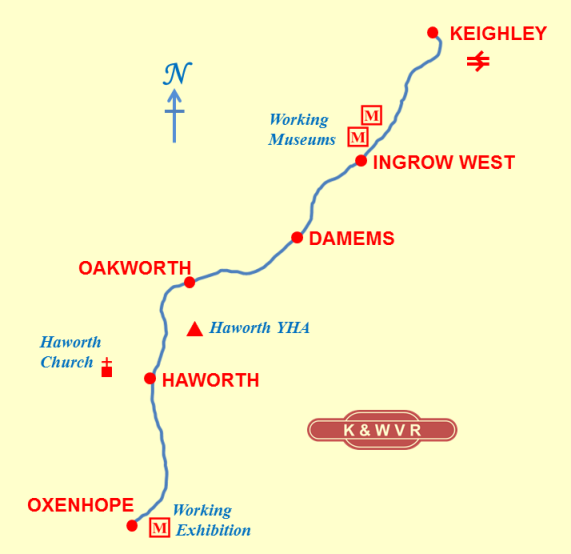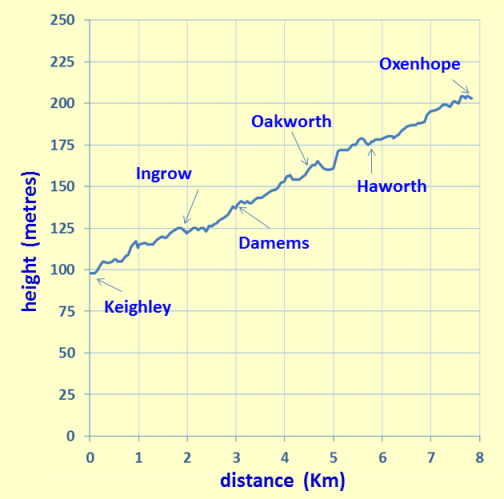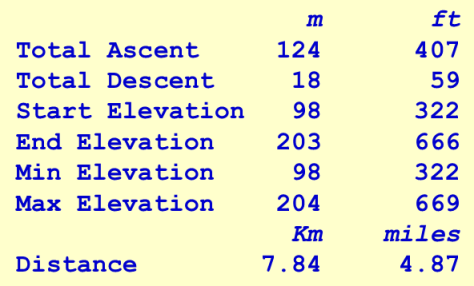 |
A Day on the WORTH VALLEY RAILWAY 2013 - August - 27 |
 |
| New Day Ingrow "Bahamas" Carriages Oxenhope Open Top Oxenhope 2 Walk Evening Read Me |
The Worth Valley Railway
There is so much to see on the Worth Valley Railway, that I thought I would make a day of it. Indeed, the heritage line very certainly lived up to my expectations! It was a jig-saw to fit everything in in a comfortable, yet timely, fashion. The aim to achieve this jig-saw is the reason for what may seem at first a bizarre chronological sequence of photographs as reflected in this chronicle of my day's experiences, but there was a method to my apparent madness. Come now and enjoy with me what was a very pleasurable - and of course, instructive - day!
The train from Keighley has just arrived at Oxenhope. The passengers have flooded on to the platform, and have a chance to admire the steam locomotive - of 1945 vintage - as it runs around its train in preparation for the return journey down the valley.
The heritage line wends its way up the verdant Worth Valley and then follows the Bridgehouse Beck to the terminus at Oxenhope. The railway was opened in 1867, with the intention of bringing coal to power the numerous cloth mills that dotted the area, and of course, of taking the cloth products from those mills to the outside world. The line suffered the Beeching axe in 1962, and it was the efforts of locals - including the late Bob Cryer MP - together with railway enthusiasts, that enabled the line to reopen in 1968, just over a century after it first opened. The 1970 version of "Railway Children" was filmed here and helped to publicise the line to a wider national and international audience.
All stations, apart from Keighley, have only one platform. The line was single-tracked throughout, but so great was the traffic on the reopened line, that a passing loop was inserted south of Damems Station to allow two trains to use the line at the same time.
|
It was the railway's goal to bring the mills their coal and take to the world outside all the cloth the mills provide. When the mills met their doom, for the railway, there was no room, until its rebirth was announced and Beeching well and truly trounced! |
There are three interesting railway-related museums "attached to" the K&WVR. However, the surrounding Brontë Country also places the line in a wider cultural context of national importance. The picturesque Haworth Village, with its church and Brontë Parsonage, is the gateway to the moors, which so influenced the novels of the Brontë sisters and also provide invigorating exercise for today's keen walker.

The Worth Valley Railway wends its picturesque way through the verdant valley.
The line is 4, 4.75 or 5 miles in length, depending on which book or pamphlet you happen to be reading at the time. My humble measurements came up with a figure of about 4.9 miles or 7.8 kilometres.

It's a steady climb up the valley.
The railway line climbs reasonably steadily up the valley, overcoming a height difference of about 100 metres or over 300 feet between Keighley and Oxenhope. This ensures that the line's steam locomotives have to work hard for their living.

Here is a summary of the main heights and distances.
The New Day Breaks
The day started with a dramatic firey sun rise at about 06:20. Colourful, yes, but what about the old adage: "Red sky in the morning, shepherd's warning"? As if to suggest that things work differently in this part of Yorkshire, the day turned out to be - weatherwise - very pleasant indeed.
Across the other side of the valley there was a brilliant morning glow ...
... which seemed to mellow as the seconds ticked away.
Train - Ingrow via Keighley
It was the day after the Bank Holiday, which means that I was lucky. In anticipation of less traffic, a rail bus was pressed into service. This enabled me to take some shots of the line as it rolled off into the distance behind the vehicle. A rail bus, like the tramcars of old, is normally bidirectional in construction and operation. I therefore travelled as far as Keighley and then went back to Ingrow West, home to two interesting, working museums.
I walked down to Haworth Station, bought my Green Day Rover Ticket and waited for the first train of the day for Keighley.
And here it was. Actually not a train, but a railbus. (I took this picture at Ingrow West later on, but it fits in here just fine.) The railbus was built in Germany in 1958, an indication of the German industry picking up again after the disasters of WWII.
This is one of the two driving consoles - solid 1950s construction.
I took advantage of the adjacent passenger seat to get a rear view of the journey. Here we are entering Mytholmes Tunnel, that featured in the tunnel scene in the "Railway Children" film.
It's a nice rural ride to Oakworth Station.
Here's saying goodbye to Oakworth,
whose station played a prominent part in the "Railway Children" film.
Just leaving Damems Station. This is reputedly the smallest railway station in Britain, but I think the platform has recently been lengthened.
This is another nice green stretch, on the way to ...
... Ingrow West Station.
Some cloth mill buildings have lingered on - for various new-found purposes - in the Worth Valley, and this small one stands guard over the approach to Keighley.
I "changed ends", and as the railbus departed, I got this picture of the Keighley Station Worth Valley platform with its hanging flower baskets and Victorian cast iron platform awning supports.
The platform at Keighley curves away up the valley. The platform itself is home to a number of period items, such as the book stand, rescued for posterity from elsewhere.
It's another rural ride, ...
... to Ingrow West, where I took this picture of the 1958 rail bus with driver and station master, as the rail bus was departing and ...
... as it was entering the mini-tunnel to the south of the station.
Bahamas Loco Museum
The Bahamas Locomotive Museum at Ingrow West is named after the owning society's 1935 Jubilee Class LMS locomotive of that name. This locomotive is being restored, which is no mean feat. The society also owns two other locomotives, one of which already sees frequent service on the K&WVR.
This industrial tank engine, called "Nunlow", dates from 1938,
and is frequently used on the K&WVR.
This is the Stanier-designed "Bahamas" locomotive, on show, but awaiting further restoration work, including a boiler overhaul - at Tyseley in Birmingham - which is needed for its 10-year safety certificate. The locomotive is of 1935 vintage.
These connecting rods can move a passenger train of well over three hundred tons, the carriages full to the gunnels with holiday makers. This represents a lot of power in the skillful hands of driver and fireman working as a team.
Vintage Carriage Museum
Rail travel of yesteryear is brought to life by the enthusiastic devotion of the members of the Vintage Carriages Trust, whose active base is this museum and restoration centre. They have invested, and are investing, their most valuable resource - spare time - into restoring and maintaining these carriages for posterity. The carriages date from 1876 up to 1951, so exhibit the changing styles and travelling habits over a significant period of railway history. Not to be missed!
This first class Metropolitan Railway (forerunner of the Metropolitan Line) carriage dates from 1923 and used to run from Aylesbury and deepest Buckinghamshire to Baker Street and Moorgate.
Railway companies used to like elaborate company crests. The Latin inscription, translates as "power harnessed serves", or, I might suggest, more elegantly, "[electrical] power harnessed to serve [the public]". The crest depicts, in clockwise rotation, the four adminstrative areas served by the Met., namely, the City of London, Middlesex, Hertfordshire and Buckinghamshire.
John Betjeman's "Metro-Land" was the area served by the Metropolitan Railway.
Here is part of the Great Central Railway carriage originally dating from 1876. The Great Central was the last mainline railway into London - at least before Eurostar - and its terminus was Marylebone.
Lady Dignified reclines in the opulence of the first class compartment, but would not have travelled in this coach on the District Line to Upminster! Her better half explains from a hidden speaker that they are visiting a friend in high places and trying out this new-fangled form of transport in the process.
Here is the Great Central's crest, as painted on the carriage.
Even the third class 1898 carriage of the Great Northern Railway (line from King's Cross) is not without its elegant exterior appearance ...
... enhanced by nicely painted monograms.
A manifestation of the humbler, but indispensible, aspects of railway operation, is this industrial saddle tank shunter, grandly named "Lord Mayor" and dating from 1893.
Here is more of a driver's view, with the engine pointing out of the museum.
A splendid arrangent of floggles, toggles and widgets has to be mastered to breathe life into this small iron horse.
Train to Oxenhope
There was another section of the line I wanted to travel on, and indeed, another museum I wanted to visit. So I took the next train, but one, to Oxenhope. Since this was not the first train of the day, it was steam hauled. More views and experiences awaited me.
The original station at Ingrow West was severely vandalised, so the present station was transported from Foulridge on the erstwhile Colne to Skipton line and rebuilt brick by brick. Of course, its style fits in with the other stations on the K&WVR.
My train was hauled by an engine built in Britain in January 1945 for the war-depleted Dutch Railways, but to the same specifications as the now apparently extinct 733 strong British type. It had a chequered career, ending up in Sweden from where it was repatriated. It was then restored by K&WVR volunteers - as closely as possible - to "British Railways" appearance and condition. This engine is an example of the "austerity" or "utility" approach to wartime products, which had to fit the purpose in as cost-, time- and, importantly, material-effective way as possible.
The broad sweep of Oakworth Station hoves into view, ...
... and then it's Haworth.
The line curves into Oxenhope, ...
... where the engine prepares for its "run-round" ritual.
Here is a close-up of the iron steed, designated as class WD (War Department) with origin MoS (Ministry of Supply). It is a freight locomotive designed to haul long trains of the materiel (yes "...iel" not "...ial") of war. It's slower than an express engine, but ideally suited for the more leisurely pace of a heritage line.
Oxenhope Exhibition
The exhibition area at Oxenhope - on the site of the former goods yard - was conceived as a parking space for vehicles that were in use or awaiting maintenance. It was an inventive ploy also to use the opportunity to show these vehicles - close up - to the visitors.
This is the GWR pannier tank, originally used with garish orange livery,
in the Railway Children film.
This line was "Lancashire and Yorshire Railway" country, and here is the company's handsome crest as sported by an L & Y coach. White rose for Yorkshire, red rose for Lancashire - of course!
In wartime, a number of European railways took delivery of American locomotives, of which this tank engine, dating from 1943, is a typical example.
After the war, concentration on modernising the steam motive power initially took precedence over the introduction of diesel and electric traction. This standard-type engine dates from 1953.
The K&WVR owns and uses two Pullman carriages, and here is the Pullman crest with English, Scottish, Welsh and Irish standards.
The train from Keighley has arrived again and is about to disgorge its passengers on to Oxenhope's only platform.
Lots of nice steam. The simple cab construction emphasises the "austerity" nature of the locomotive. With an "8F" designation it is a powerful freight locomotive.
This is how to drive it!
The "late-1950s-early-1960s" house style successfully pervades the K&WVR.
Dark red paint and chalked notices with Victorian ticket window and fireplace. No computerised display boards, self-service ticket machines or central heating.
By Open-Topper over the Moors from Oxenhope to Ingrow
A Southdown (Brighton area) open top bus (1970s vintage) provided a bone-shaking view of the moors, as it plyed between Oxenhope, Haworth and Ingrow West. Memories of sea-side visits as a kid. Tempus irreparabile fugit!
The "Queen Mary" open topper, in all its Southdown green and cream glory, awaits passengers at Oxenhope.
Taking pictures from the bone-shaking top deck was a challenge. This view is taken on the stretch between Haworth and Ingrow.
The bus has safely arrived at Ingrow West, its passengers having been treated to a short, but detailed "audio-enlightened", tour of the moors.
Another Train to Oxenhope
This, I planned, would be my last ride on the K&WVR. It would be a chance to catch up on any sights or experiences that might have eluded my consciousness earlier in the day. After that, how about a walk from Oxenhope to Haworth Village?
Looking after a heritage line is a labour of love - many labours infact! Making a station look clean and pretty with hanging flower baskets is part of the overall praiseworthy scheme.
The penultimate train of the day arrives, headed by our wartime stalwart.
Walk from Oxenhope to Haworth Village
This walk soon rose to higher ground after crossing the railway line. Some good valley views later, I reached Haworth Village via the churchyard. The route took in part of the Railway Childrens' Walk and the Brontë Way.
Higher ground has been reached, and this is a southerly moorland view near Marsh Top.
After Old Oxenhope Farm,
a view to the southern reaches of Haworth and to the Worth Valley unfolds.
An informative signpost keeps the walker on the straight and narrow.
Worth Valley and a dry-stone wall.
Summer is in full swing - trees, flowers and greenery all abound.
Yes, summer is here with a vengeance!
And so to Haworth church.
Gravestones often make interesting reading. In past times, many in these parts died young, despite the rural landscape. The "Good Old Days" were not always that good, for lack of medical and dietary knowledge often took its toll.
Another view of the Brontë Parsonage reminds us that most of the Brontë family also died well before reaching "three score and ten".
Last Evening in Haworth
It had been a very enjoyable day, with lots of new experiences and impressions, from which I had learnt a lot. Life is a process of continuous education, and today was yet another fine example of that adage. Now it was time to enjoy the closing of the day.
Hotels are sometimes embellished with decorative, but nowadays probably not that useful, examples of items from yesteryear. This looks like a 17th Century "combi" - a store cupboard whose contents could be guarded by the owner sitting on them, if he or she did not mind the hard seat.
On the roof diagonally opposite the window of my room, sociable corvids were congregating to see out the parting day.
Heavy clouds darkened the sky ...
... and soon countless lights lit up the valley. Night had fallen like a cloak over the events of the day.
